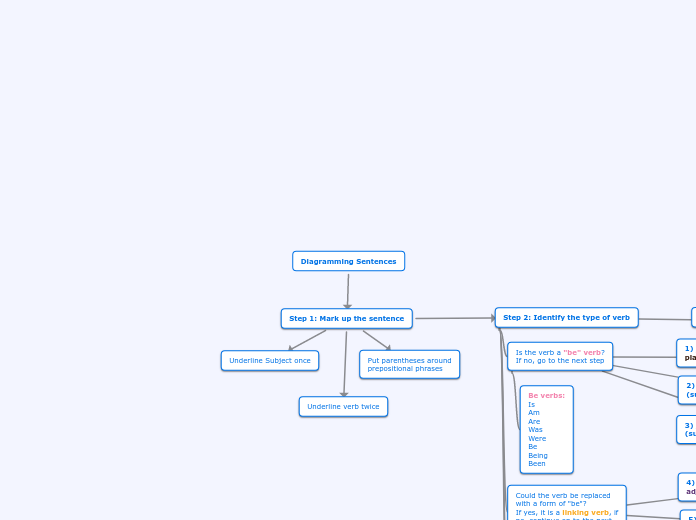Diagramming Sentences
Step 1: Mark up the sentence
Underline Subject once
Underline verb twice
Put parentheses around
prepositional phrases
Step 2: Identify the type of verb
Is the verb a "be" verb?
If no, go to the next step
Be verbs:
Is
Am
Are
Was
Were
Be
Being
Been
Could the verb be replaced
with a form of "be"?
If yes, it is a linking verb, if
no, continue on to the next
verb type
Is there an object after the
verb? If not, it is an
intransitive verb, but if so,
see the next verb type
If there is an object after the
verb, it is a transitive verb
1) Subject - "be" verb - adverb of time or place
Notes:
*S - be - adv/tp
*Nothing follows verb on top line, it goes underneath the verb instead
*EX: The king is here, or, The king is on the throne
2) Subject - "be" verb - predicate adjective (subjective complement)
Notes:
*S - be - pa
*Can have a pedestal
*The king will be generous
3) Subject - "be" verb - predicate noun (subjective complement)
Notes:
*S - be - pn
*The king is a friend
4) Subject - linking verb - predicate adjective (subjective complement)
Notes:
*S - lv - pa
*Can have a pedestal
*The king seems unhappy
5) Subject - linking verb - predicate noun (subjective complement)
Notes:
*S - lv - pn
*The king became a tyrant
6) Subject - intransitive verb
Notes:
*S - itv
*Just like in pattern 1, nothing follows verb on top line, goes underneath verb instead
*The king coughed
7) Subject - transitive verb - direct object
Notes:
*S - tv - do
*The king proclaimed the news
8) Subject - transitive verb - indirect object - direct object
Notes:
*S - tv - io - do
*If you see 2 nouns in a row, it’s probably this one
*The king gave Anne his love
9) Subject - transitive verb - direct object - adjective (objective complement)
Notes:
*S - tv - do - adj
*The king considered Anne beautiful
*Can have a pedestal
*Can have the floating “as” thingy
10) Subject - transitive verb - direct object - noun (objective complement)
Notes:
*S - tv - do - n
*Can have the floating “as” thingy
*The king considered Anne a beauty
Step 3: Identify the sentence pattern
Extra Notes that are helpful to have
Direct Object
*Answers the question “whom” or “what” after the verb, if you take it out, sentence no longer makes sense
*Always gonna follow verb with the straight line thing
Indirect Object
*Answers one of six questions: to whom? For whom? Of whom? To what? For what? If you take it out, the sentence can still make sense
*Always gonna be underneath verb as the “L” shaped slanty noun thing
Objective Complement (9&10)
*Definition: An adjective or noun that modifies or renames the direct object
*Can insert “to be” in front of it
*Test:
-Necessary to sentence meaning
-Must rename or modify the direct object
*If it is a prep. Phrase, goes on a pedestal
PREDICATE just means the section of a sentence that has the verb in it, and states something about the subject
PREPOSITIONAL PHRASE just means a preposition that’s not one word, like a portion of a sentence. Prepositions are the ones that could be done to a box, next to, inside, on, etc.
*Anything following the word “of” is gonna be a prep. phrase
*Will have a noun inside
*If you find a random noun you don’t know what to do with, check around it, it might be a prep. phrase
